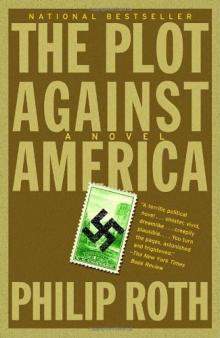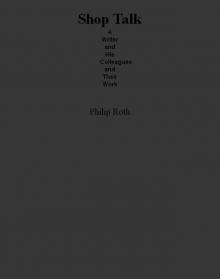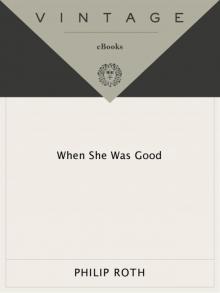- Home
- Philip Roth
The plot against America Page 3
The plot against America Read online
Page 3
On Sunday night we waited through the lineup of comedy programs for Walter Winchell to come on at nine. And when he did and proceeded to say what we had hoped he would say just as contemptuously as we wanted him to say it, applause erupted from across the alleyway, as though the famous newsman weren't walled off in a radio studio on the far side of the great divide that was the Hudson but were here among us and fighting mad, his tie pulled down, his collar unbuttoned, his gray fedora angled back on his head, lambasting Lindbergh from a microphone atop the oilcloth covering on the kitchen table of our next-door neighbor.
It was the last night of June 1940. After a warm day, it had grown cool enough to sit comfortably indoors without perspiring, but when Winchell signed off at nine-fifteen, our parents were moved to go outside for the four of us to take in the lovely evening together. We were just going to walk to the corner and back—after which my brother and I would go to sleep—but it was nearly midnight before we got to bed and by then sleep was out of the question for kids so overcome by their parents' excitement. Because Winchell's fearless bellicosity had propelled all of our neighbors outdoors as well, what had begun for us as a cheerful little evening stroll ended as an impromptu block party for everyone. The men dragged beach chairs from the garages and unfolded them at the foot of the alleyways, the women carried pitchers of lemonade from the houses, the youngest of the children ran wildly from stoop to stoop, and the older ones sat laughing and talking off by themselves, and all because war had been declared on Lindbergh by America's best-known Jew after Albert Einstein.
It was Winchell, after all, whose column had famously ushered in the three dots separating—and somehow magically validating—each hot news item ever so tenuously grounded in fact, and it was Winchell who'd more or less originated the idea of firing into the face of the credulous masses buckshot pellets of insinuating gossip—ruining reputations, compromising celebrities, bestowing fame, making and breaking showbiz careers. It was his column alone that was syndicated in hundreds of papers all across the country and his Sunday-night quarter of an hour that was the country's most popular news program, the rapid-fire Winchell delivery and the pugnacious Winchell cynicism lending every scoop the sensational air of an expose. We admired him as a fearless outsider and a cunning insider, a pal of J. Edgar Hoover, director of the FBI, as well as a neighbor of the mobster Frank Costello and a confidant of Roosevelt's inner circle, even a sometimes guest invited to the White House to amuse the president over a drink—the in-the-know street fighter and hardboiled man about town whom his enemies feared and who was on our side. Manhattan-born Walter Winschel (a.k.a. Weinschel) had transformed himself from a New York vaudeville dancer into a callow Broadway columnist earning big money by embodying the passions of the cheesiest of the new subliterate dailies, though ever since the rise of Hitler, and long before anyone else in the press had the foresight or the wrath to take them on, fascists and anti-Semites had become his number one enemy. He'd already labeled as "ratzis" the German-American Bund and hounded its leader, Fritz Kuhn, over the air and in print as a secret foreign agent, and now—after FDR's joke, the Newark News editorial, and the thoroughgoing denunciation by PM—Walter Winchell had only to disclose Lindbergh's "pro-Nazi philosophy" to his thirty million Sunday-evening listeners and to call Lindbergh's presidential candidacy the greatest threat ever to American democracy for all the Jewish families on block-long little Summit Avenue to resemble once again Americans enjoying the vitality and high spirits of a secure, free, protected citizenry instead of casting themselves about outdoors in their nightclothes like inmates escaped from a lunatic asylum.
My brother was known throughout the neighborhood for being able to draw "anything"—a bike, a tree, a dog, a chair, a cartoon character like Li'l Abner—though his interest of late was in real faces. Kids were always gathering around to watch him wherever he would park himself after school with his large spiral pad and his mechanical pencil and begin to sketch the people nearby. Inevitably the onlookers would start to shout, "Draw him, draw her, draw me," and Sandy would take up the exhortation, if only to stop them from screaming in his ear. All the while his hand was working away, he'd look up, down, up, down—and behold, there lived so-and-so on a sheet of paper. What's the trick, they all asked him, how'd you do it, as if tracing—as if outright magic—might have played some part in the feat. Sandy's answer to all this pestering was a shrug or a smile: the trick to doing it was his being the quiet, serious, unostentatious boy that he was. Compelling attention wherever he went by turning out the likenesses people requested had seemingly no effect on the impersonal element at the core of his strength, the inborn modesty that was his toughness and that he later sidestepped at his peril.
At home, he was no longer copying illustrations from Collier's or photos from Look but studying from an art manual on the figure. He'd won the book in an Arbor Day poster contest for schoolkids that had coincided with a citywide tree-planting program administered by the Department of Parks and Public Property. There'd even been a ceremony where he'd shaken the hand of a Mr. Bann-wart, who was superintendent of the Bureau of Shade Trees. The design of his winning poster was based on a red two-cent stamp in my collection commemorating the sixtieth anniversary of Arbor Day. The stamp seemed to me especially beautiful because visible within each of its narrow, vertical white borders was a slender tree whose branches arched at the top to meet and form an arbor—and until the stamp became mine and I was able to examine through my magnifying glass its distinguishing marks, the meaning of "arbor" had been swallowed up in the familiar name of the holiday. (The small magnifying glass—along with an album for twenty-five hundred stamps, a stamp tweezers, a perforation gauge, gummed stamp hinges, and a black rubber dish called a watermark detector—had been a gift from my parents for my seventh birthday. For an additional ten cents they'd also bought me a small book of ninety-odd pages called The Stamp Collector's Handbook, where, under "How to Start a Stamp Collection," I'd read with fascination this sentence: "Old business files or private correspondence often contain stamps of discontinued issues which are of great value, so if you have any friends living in old houses who have accumulated material of this sort in their attics, try to obtain their old stamped envelopes and wrappers." We didn't have an attic, none of our friends living in flats and apartments had attics, but there'd been attics just beneath the roofs of the one-family houses in Union—from my seat in the back of the car I could see little attic windows at either end of each of the houses as we'd driven around the town on that terrible Saturday the year before, and so all I could think of when we got home in the afternoon were the old stamped envelopes and the embossed stamps on the prepaid newspaper wrappers secreted up in those attics and how I would now have no chance "to obtain" them because I was a Jew.)
The appeal of the Arbor Day commemorative stamp was greatly enhanced by its representing a human activity as opposed to a famous person's portrait or a picture of an important place—an activity, what's more, being performed by children: in the center of the stamp, a boy and a girl looking to be about ten or eleven are planting a young tree, the boy digging with a spade while the girl, supporting the trunk of the tree with one hand, holds it steadily in place over the hole. In Sandy's poster the boy and the girl are repositioned and stand on opposite sides of the tree, the boy is pictured as right-handed rather than left-handed, he wears long pants instead of knickers, and one of his feet is atop the blade pressing it into the ground. There is also a third child in Sandy's poster, a boy about my age, who is now the one wearing the knickers. He stands back and to the side of the sapling and holds ready a watering can—as I held one when I modeled for Sandy, clad in my best school knickers and high socks. Adding this child was my mother's idea, to help distinguish Sandy's artwork from that on the Arbor Day stamp—and protect him from the charge of "copying"—but also to provide the poster with a social content that implied a theme by no means common in 1940, not in poster art or anywhere else either, and that for reasons of "ta
ste" might even have proved unacceptable to the judges.
The third child planting the tree was a Negro, and what encouraged my mother to suggest including him—aside from the desire to instill in her children the civic virtue of tolerance—was another stamp of mine, a brand-new ten-cent issue in the "educators group," five stamps that I'd purchased at the post office for a total of twenty-one cents and paid for over the month of March out of my weekly allowance of a nickel. Above the central portrait, each stamp featured a picture of a lamp that the U.S. Post Office Department identified as the "Lamp of Knowledge" but that I thought of as Aladdin's lamp because of the boy in the Arabian Nights with the magic lamp and the ring and the two genies who give him whatever he asks for. What I would have asked for from a genie were the most coveted of all American stamps: first, the celebrated 1918 twenty-four-cent airmail, a stamp said to be worth $ 3, 400, where the plane pictured at the center, the Army's Flying Jenny, is inverted; and after that, the three famous stamps in the Pan-American Exposition issue of 1901 that had also been mistakenly printed with inverted centers and were worth over a thousand dollars apiece.
On the green one-cent stamp in the educators group, just above the picture of the Lamp of Knowledge, was Horace Mann; on the red two-cent, Mark Hopkins; on the purple three-cent, Charles W. Eliot; on the blue four-cent, Frances E. Willard; on the brown ten-cent was Booker T. Washington, the first Negro to appear on an American stamp. I remember that after placing the Booker T. Washington in my album and showing my mother how it completed the set of five, I had asked her, "Do you think there'll ever be a Jew on a stamp?" and she replied, "Probably—someday, yes. I hope so, anyway." In fact, another twenty-six years had to pass, and it took Einstein to do it.
Sandy saved his weekly allowance of twenty-five cents—and what change he earned shoveling snow and raking leaves and washing the family car—until he had enough to bicycle to the stationery store on Clinton Avenue that carried art supplies and, over a period of months, to buy a charcoal pencil, then sandpaper blocks to sharpen the pencil, then charcoal paper, then the little tubular metal contraption he blew into to apply the fine fixative mist that prevented the charcoal from smudging. He had big bulldog clips, a masonite board, yellow Ticonderoga pencils, erasers, sketchpads, drawing paper—equipment that he stored in a grocery carton at the bottom of our bedroom closet and that my mother, when she was cleaning, wasn't permitted to disturb. His energetic meticulousness (passed on from our mother) and his breathtaking perseverance (passed on from our father) served only to magnify my awe of an older brother who everyone agreed was intended for great things, while most boys his age didn't look as though they were intended even to eat at a table with another human being. I was then the good child, obedient both at home and at school—the willfulness largely inactive and the attack set to go off at a later date—as yet altogether too young to know the potential of a rage of one's own. And nowhere was I less intransigent than with him.
For his twelfth birthday, Sandy had gotten a large, flat black portfolio made of hard cardboard that folded along a sewn seam and was secured at the top edge with two attached lengths of ribbon that he tied in a bow in order to fasten the leaves. The portfolio measured about two feet by a foot and a half, too big to fit into the drawers of our bedroom dresser or to be stacked upright against the wall in the crowded bedroom closet he and I shared. He was allowed to store it—along with his spiral sketchpads—laid out flat beneath his bed, and in it he saved the drawings he considered his best, beginning with his compositional masterwork of 1936, the ambitious picture of our mother pointing overhead at the Paris-bound Spirit of St. Louis. Sandy had several large portraits of the heroic aviator, in both pencil and charcoal, stowed away in his portfolio. They were part of a series he was assembling of prominent Americans that concentrated primarily on those living eminences most revered by our parents, such as President and Mrs. Roosevelt, New York mayor Fiorello La Guardia, United Mine Workers president John L. Lewis, and the novelist Pearl Buck, who'd won the Nobel Prize in 1938 and whose picture he copied from the jacket of one of her bestsellers. A number of drawings in the portfolio were of family members, and of those at least half were of our sole surviving grandparent, our paternal grandmother, who, on the Sundays when my uncle Monty brought her around to visit, would sometimes serve Sandy as a model. Under the sway of the word "venerable," he drew every wrinkle he could find in her face and every gnarl in her arthritic fingers while—as dutifully as she'd scrubbed floors on her knees all her life and cooked for a family of nine on a coal stove—tiny, sturdy Grandma sat in the kitchen and "posed."
We were alone together in the house only a few days after the Winchell broadcast when Sandy removed the portfolio from under his bed and carried it into the dining room. There he opened it out on the table (reserved for entertaining the Boss and celebrating special family occasions) and carefully lifted the Lindbergh portraits from the tracing paper protecting each drawing and lined them up on the tabletop. In the first, Lindbergh was wearing his leather flying cap with the loose straps dangling over each ear; in the second, the cap was partially hidden beneath large heavy goggles pushed up from his eyes and onto his forehead; in the third, he was bareheaded, nothing to mark him as an aviator other than the uncompromising gaze out to the distant horizon. To gauge the value of this man, as Sandy had rendered him, wasn't difficult. A virile hero. A courageous adventurer. A natural person of gigantic strength and rectitude combined with a powerful blandness. Anything but a frightening villain or a menace to mankind.
"He's going to be president," Sandy told me. "Alvin says Lindbergh's going to win."
He so confused and frightened me that I pretended he was making a joke and laughed.
"Alvin's going to go to Canada and join the Canadian army," he said. "He's going to fight for the British against Hitler."
"But nobody can beat Roosevelt," I said.
"Lindbergh's going to. America's going to go fascist."
Then we just stood there together under the intimidating spell of the three portraits. Never before had being seven felt like such a serious deficiency.
"Don't tell anybody I've got these," he said.
"But Mom and Dad saw them already," I said. "They've seen them all. Everybody has."
"I told them I tore them up."
There was nobody more truthful than my brother. He wasn't quiet because he was secretive and deceitful but because he never bothered to behave badly and so had nothing to hide. But now something external had transformed the meaning of these drawings, making them into what they were not, and so he'd told our parents that he'd destroyed them, making himself into what he was not.
"Suppose they find them," I said.
"How will they do that?" he asked.
"I don't know."
"Right," he said. "You don't. Just keep your little trap shut and nobody'll find anything."
I did as he told me for many reasons, one being that the third-oldest U.S. postage stamp I owned—which I couldn't possibly tear up and throw away—was a ten-cent airmail issued in 1927 to commemorate Lindbergh's transatlantic flight. It was a blue stamp, about twice as long as it was high, whose central design, a picture of the Spirit of St. Louis flying eastward over the ocean, had provided Sandy with the model for the plane in the drawing celebrating his conception. Adjacent to the white border at the left of the stamp is the coastline of North America, with the words "New York" jutting out into the Atlantic, and adjacent to the border at the right the coastlines of Ireland, Great Britain, and France, with the word "Paris" at the end of a dotted arc that charts the flight path between the two cities. At the top of the stamp, directly beneath the white letters that boldly spell out UNITED STATES POSTAGE are the words LINDBERGH–AIR MAIL in slightly smaller type but large enough certainly to be read by a seven-year-old with perfect vision. The stamp was already valued at twenty cents by Scott's Standard Postage Stamp Catalogue, and what I immediately realized was that its worth would only continue increasing (
and so rapidly as to become my single most valuable possession) if Alvin was right and the worst happened.

 American Pastoral
American Pastoral The plot against America
The plot against America The Human Stain
The Human Stain Nemesis n-4
Nemesis n-4 Sabbath’s Theater
Sabbath’s Theater The Professor of Desire
The Professor of Desire Our Gang
Our Gang The Breast
The Breast Operation Shylock
Operation Shylock The Dying Animal
The Dying Animal Letting Go
Letting Go The Counterlife
The Counterlife Everyman
Everyman Nemesis
Nemesis Exit Ghost
Exit Ghost Portnoy's Complaint
Portnoy's Complaint My Life as a Man
My Life as a Man I Married a Communist
I Married a Communist The Anatomy Lesson
The Anatomy Lesson The Great American Novel
The Great American Novel Shop Talk
Shop Talk The Humbling
The Humbling Zuckerman Unbound
Zuckerman Unbound When She Was Good
When She Was Good The Prague Orgy
The Prague Orgy American Pastoral (Nathan Zuckerman)
American Pastoral (Nathan Zuckerman) Goodbye, Columbus
Goodbye, Columbus Reading Myself and Others
Reading Myself and Others